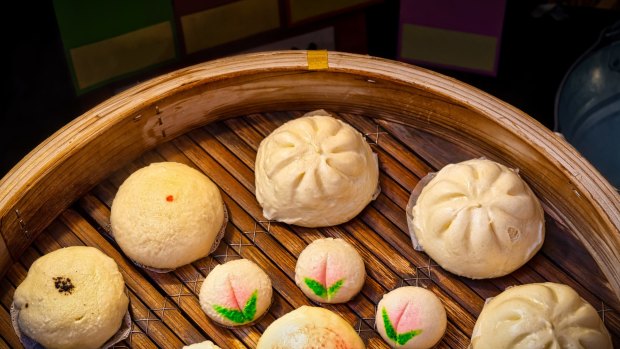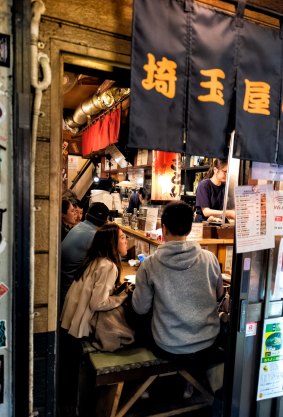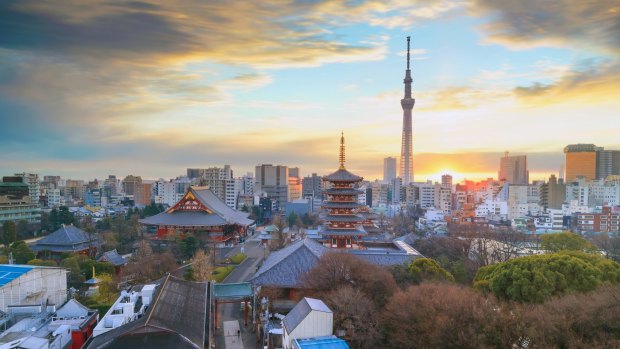This was published 4 years ago
Best places to eat in Japan: If you're hungry in Tokyo, underground is the way to go
By Ben Groundwater

Asian dumplings, or dim sum, cooking in a wooden steamer in Yokohama's Chinatown, near Tokyo.Credit: iStock
It is 35 steps down to the front door, 35 steps that take you deep into Tokyo's murky depths, each pace a descent that forces you to question whether this really is such a good idea after all.
The steps wind down in a dimly lit spiral, where you can never peer more than a metre or so ahead. This is Tokyo, too, so you are rarely 100 per cent sure you are in the right place. Is this even a restaurant? There was no sign out the front. The inexorable descent from the familiarity of the street outside only serves to heighten the tension.
And then you reach the wooden door, slide it ajar, and the cacophony of a busy Tokyo izakaya roars through the gap. Welcome.

Inside an izakaya, a type of informal Japanese pub.Credit: iStock
Next minute you are seated at the bar, pouring sake from a bamboo pitcher. You are watching a chef prep a sashimi platter, the long blade of his knife sliding through seafood, whole fish becoming beautiful plates of bite-sized morsels. You are laughing as a waiter brings over a fillet of mackerel, tells you to get ready with a wedge of lime, sears the fish with a blow torch and then motions for you to squeeze the citrus, yelling, "Good juice! Good juice!".
Other diners smile and toast you with glasses of sake or beer.
Up on street level in the busy suburb of Shibuya, you would never know 35 Steps exists. You would never guess at the frivolity taking place in this laid-back, fun izakaya far beneath your feet. You wouldn't know what awaits those who venture into Tokyo's depths.

Tokyo at twilight.Credit: iStock
This underground restaurant is typical of the Japanese capital. As intimidatingly huge as this place can seem from street level, as incredibly sprawling as it is when viewed from a height, there is still more here. There is a whole world that exists below ground level in Tokyo, an entire city in its own right, a network of shops and restaurants, bars and izakayas, concert venues and theatres beneath your feet.
The trick is simply remembering that they're there. As you gaze upon a Tokyo cityscape and try to make sense of the brightly lit shopfronts and the neon-fringed towers laden with signage that stretch up into the sky, you need to remind yourself that there are attractions below your feet too, that some of Tokyo's finest establishments are buried underground.
Think of the city as a forest: for every trunk and branch you see reaching towards the sky, there is a network of roots below, holding the whole thing in place, as important to the ecosystem as anything you can see.
None of these subterranean venues should be thought of as intimidating, either, or in any way dangerous. The underground here is just a space to utilise in a city that has so little of it to spare. It is a way to create atmosphere, to ensure intimacy. It is a place to escape, to get away from the bustle of the street and the lights of the skyscrapers, and to exist in a curated underworld.
Some of Tokyo's best food can be found below ground level, from casual restaurants to food halls to world-famous fine-dining eateries. The city's eponymous main train station is the perfect example. Head below ground level at Tokyo station and you will discover Ramen Street, a walkway lined with restaurants serving ramen noodles, where people queue for an hour to try the tsukumen – noodles served dry, designed to be dipped in hot soup and then wolfed down – at Rokurinsha, or the rich, porky tonkotsu at Oreshiki Jun.
A short walk away, Kitchen Street is a warren of underground alleys lined with restaurants, where you can pick up sushi or deep-fried snacks on sticks, tempura or katsu, udon or okonomiyaki. You could spend an entire day just wandering the basement halls of Tokyo station, shopping and eating.
Fine-dining restaurants exist below street level in Tokyo, too. Sukiyabashi Jiro, perhaps the most famous sushi restaurant in the world, can be found on the basement floor of a Ginza office block. Izakayas also reside in the city's murky depths: 35 Steps in Shibuya; Uoshin, a basement-level seafood izakaya in Ebisu; Kagaya, an underground madhouse that is as much performance art as eatery, is set below trendy Ginza.
And then you have Tokyo's true underground gourmet treasures: "depachikas" – the gourmet food halls that are housed in the basement levels of major department stores such as Takashimaya, Mitsukoshi, Daimaru and Isetan. Each depachika is a huge, sprawling melange of edible delights, from pre-cooked takeaway meals that cross the full spectrum of Japanese cuisine, to artisanal breads and pastries, gourmet imported goods, and impossibly large selections of wine and spirits and sake.
To find a depachika you just have to enter a department store and take the escalators down as far as they'll go: deliciousness awaits in the brightly lit depths.
And still you are not done with Tokyo's underground world. Vast networks of concealed walkways connect train stations and major buildings, alleys that are lined with shops and eateries. Even the city's finest hotels, the likes of the Tokyo Palace in Ginza, and Keio Plaza in Shinjuku, have underground malls where shops sell designer kitchen goods, high-end textiles or French chocolates.
As popular as Tokyo's underground world is by day, it truly comes into its own at night, when the city's immense population makes its way from the heights of skyscraper offices to the depths of the best drinking dens. In Shibuya and Shinjuku, Ebisu and Roppongi, where office towers crowd like commuters waiting for a train, there is a great deal of fun to be had below the street.
Some of Tokyo's best bars are tiny places with only a few seats, accessible by narrow staircases rarely marked with anything as convenient as a sign. Cask Strength in Roppongi is made to look like a Scottish castle, complete with stone passageway leading into a subterranean leather-and-tartan chamber. Campbelltoun Loch is another faux-Scottish whisky den, this time in Chiyoda. Ginza S is a classic speakeasy-style cocktail bar set below street level in the suburb of the same name.
Underground is also the ideal place to have a concert venue, as you discover at places such as Shelter, a legendary rock club set on the basement level of a residential block in trendy Shimokitazawa. You'll find something similar at 20000V in Higashi-Koenji. It is dark and crowded and noisy in these places, sound bounces off thick walls, cigarette smoke billows and curls and hangs in the air. The music runs the full gamut from pop to experimental to hardcore metal. The crowds are always polite and friendly. The drinks are cheap.
There is a certain level of trepidation involved in accessing these venues, a certain wonder at whether you have come to the right place, whether you will be welcome, whether good things happen below street level, if underground really is the right place to be. And it is. Each step down takes you closer to the truth.
TRIP NOTES
MORE
FLY
ANA flies to Tokyo Haneda daily from Sydney and from Melbourne via Sydney with Virgin Australia. See ana.co.jp
STAY
The Keio Plaza Shinjuku has beautiful rooms in the perfect location, walking distance to Shinjuku train station and other attractions. See keioplaza.com
FIVE ELEVATED TOKYO ATTRACTIONS
TOKYO SKYTREE
Japan's tallest structure has become one of its most popular tourist attractions. The queues are always long to ride the elevator to the 450-metre-high observation deck at the Tokyo Skytree, from where, on a clear day, visitors enjoy spectacular views of Mount Fuji behind the city skyline. See tokyo-skytree.jp
MORI ART MUSEUM
Set on the 53rd floor of the Mori Tower in Roppongi Hills, the Mori Art Museum houses a regularly changing display of modern art that traverses numerous styles and media, but is always interesting, and always shares the limelight with one of Tokyo's best views. See mori.art.museum
NEW YORK BAR
The hotel bar made famous by Bill Murray and Scarlett Johansson in Lost in Translation is one of Tokyo's most memorable spots to drink a cocktail and while away an evening. New York Bar is set on the 52nd floor of the Park Hyatt in Shinjuku, and the views of the city nightscape are amazing. See restaurants.tokyo.park.hyatt.co.jp
RESTAURANT FLOORS
It's not just the basement-level food halls to seek out in Tokyo department stores: most of these establishments, as well as shopping malls and major train stations, reserve their top two levels for restaurants, which are usually family-friendly and don't require reservations.
TOKYU HANDS
This amazing department store in Shibuya stocks pretty much every knick-knack you could ever need, from kitchen supplies to travel gear to stationery to fabric. The store begins at ground level but rises seven stories. See tokyu-hands.co.jp/en
Ben Groundwater travelled at his own expense.
Sign up for the Traveller Deals newsletter
Get exclusive travel deals delivered straight to your inbox. Sign up now.